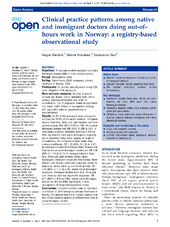Clinical practice patterns among native and immigrant doctors doing out-of-hours work in Norway: a registry-based observational study
Peer reviewed, Journal article
Published version
Permanent lenke
https://hdl.handle.net/1956/9762Utgivelsesdato
2012-07-12Metadata
Vis full innførselSamlinger
Originalversjon
https://doi.org/10.1136/bmjopen-2012-001153Sammendrag
Objectives: To evaluate whether immigrant and native Norwegian doctors differ in their practice patterns. Design: Observational study. Setting: Out-of-hours (OOH) emergency primary healthcare in Norway, 2008. Participants: All primary care physicians doing OOH work, altogether 4165 physicians. Main outcome measures: Number of patient contacts per doctor. Use of laboratory tests, minor surgery, sickness certification and length of consultations. Use of diagnoses related to psychiatric and sexual health. Choice of management strategy with psychiatric patients (psychotherapy or hospitalisation). Results: 21.4% of the physicians were immigrants, and they had 30.6% of the patient contacts. Immigrant doctors from Asia, Africa and Latin America had most patient contacts, 633 (95% CI 549 to 716), while native Norwegian doctors had 306 (95% CI 288 to 325). In multivariate analyses, immigrant physicians did not differ significantly from native Norwegians regarding use of laboratory tests, minor surgery or length of consultations, but immigrant doctors wrote more sickness certificates, OR 1.75 (95% CI 1.24 to 2.47) for immigrant doctors from Europe, North America and Oceania versus native Norwegian doctors and OR 1.56 (95% CI 1.15 to 2.11) for immigrant doctors from Asia, Africa and Latin America versus native Norwegians. Immigrant physicians from Europe, North America and Oceania used more diagnoses related to pregnancy, family planning and female genitals, OR 1.55 (95% CI 1.11 to 2.16), versus native Norwegian physicians. Immigrant doctors from Asia, Africa and Latin America used less psychiatric diagnoses, OR 0.71 (95% CI 0.53 to 0.95), versus native Norwegian doctors but did not differ significantly in their management of recognised psychiatric illness. Conclusions: Immigrant doctors make an important contribution to OOH emergency primary healthcare in Norway. The authors found only modest evidence that their clinical practice patterns are different from that of native Norwegian doctors.

